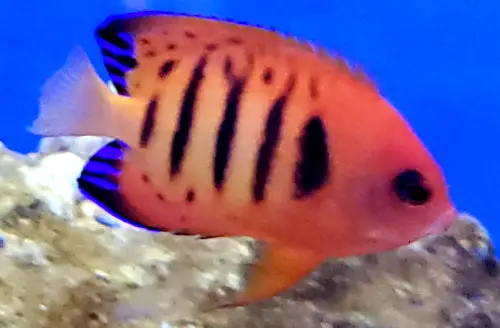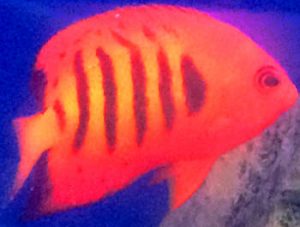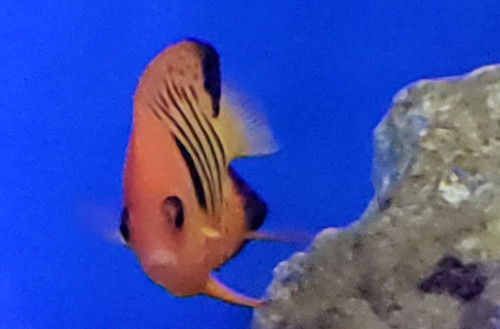
Centropyge loricula
| Difficulty | Medium |
| Minimum Tank Size | 70 Gallons |
| Diet | Omnivore |
| Water Parameters | 72-78 F, pH 8-8.4, Salinity 1.020-1.025 |
| Aggression | Semi-Aggressive |
| Size | 4" |
The Flame Angelfish, also known as the dwarf flame angelfish, is a mid sized, eye catching free swimming fish that can easily become the main attraction in a tank. Their bright red bodies have several black stripes down the sides while the back of their body is a beautiful contrasting blue. They are generally easy to care for, however they will nip at corals frequently and are sensitive to high levels of copper and low pH.
When selecting a Flame Angelfish in person you will want to look for a few factors:
- Is the fish well fed/a bit chubby?
- Do their eyes watch the tank and the other fish, or does are his eyes less focused?
- Does the fish make themselves difficult to catch?
If you do have the convenience of selecting your fish in person you will want a slightly fat, hard to catch fish with attentive eyes. They will transition into new tanks with greater ease, giving you a new happy fish with as little trouble as possible.

When well cared for the Flame Angelfish can easily live over eight years. To achieve this your tank should be stress free with fairly consistent water parameters. Most notably keep the pH above 8, with 8.2-8.3 being an ideal safe zone. If you use a reverse osmosis filter to create new tank water you may need to raise the pH before adding this water, as the process often creates a very low pH.

Behavior & Aggression
While the Flame Angelfish is not inherently aggressive, they can create a few issues. The biggest factor here is tank size and available real estate. When space is limited the Flame Angelfish can often be seen guarding its home from any passing fish, giving it a somewhat aggressive attitude. A medium sized tank with only one or two coves will be difficult to house multiple semi-aggressive fish. Instead you will want to either up the number of rocks, increase the tank size or rearrange the current tank. The goal here is to make as many homes as possible. This will allow your Flame Angelfish to roam the tank freely without having to constantly protect their home.
The Flame Angelfish is generally not reef safe as they have a bad habit of grazing on corals. While they may not eat the coral directly, their constant eating of the corals slimes and foods will lead to the slow death of many corals. This can be combated by having a large number of corals, making the occasional grazing not harmful enough to damage the corals
The Flame Angelfish is aggressive towards its own kind as well as fish who look similar. This means unless you can form a pair, keeping two Flame Angelfish together, even in a large tank, is not possible. Similarly small fish, such as gobies and young blennies, can also be at risk. This is however prevented by a larger tank and regular feeding. With enough space the smaller fish can hide when they need to, making them a less appealing target for the Flame Angelfish.
The Flame Angelfish will spend a lot of its free time grazing on the tanks algae, frequently nipping at the rocks and glass. The more mature live rock you have the better. Otherwise the fish may look to its tank mates for additional food.
When selecting fish it is important to consider the order that you will add them to the tank. The Flame Angelfish is somewhat aggressive towards new tank mates and should not be added first unless they will be the smallest fish in the tank.
Tank mates For The Flame Angelfish
Here’s a quick checklist you should run on any fish you would like to keep with the Flame Angelfish:
- Is the fish large enough to eat the angelfish?
- Is the fish fast enough to compete with the angelfish during feeding time?
- Does the fish have small appendages? The flame may pick at these when not well fed.
Poor choices for tank mates are:
- Very small shrimp, large shrimp are fine
- Worms, including feather dusters and bristle worms
Additionally you may add some smaller predators to the tank, however you will need to take extra care in feeding those fish. The Snowflake Eel for example is frequently kept with the Flame Angelfish, however the eel must be fed consistently and before the fish. Having predators compete with non predators is a bad idea in general. Additionally it is best to avoid feeding the predators fish, frozen or live, as this will increase the odds of attack on tank mates.
Diet & Feeding
While the Flame Angelfish is considered an omnivore they are actually algae eating fish. While they will accept almost any food you will want a diet specialized for algae eating fish rather than generic tropical fish foods. Mysis shrimp and spirulina enriched foods are also excellent choices, as are many of the commercial angel formula foods.
You should feed your Flame Angelfish no less than twice a day and no less than three minutes worth of feeding for the tank. Combine this with the best protein skimmer you have to reduce any excessive waste. Additionally rinse off any frozen foods you have, as the juices will spread to the tank and not be eaten by the fish.
If you have a young angelfish you may need to feed them smaller, more frequent meals. Many owners will lose fish, thinking it is only their younger age and weaker immune system than led to their death. Often the smaller fish simply needs more food than it can hold in two feedings. Once the fish ages they are able to eat more at once and can be reduced to two larger feedings per day.
Another frequent mistake with Flame Angelfish is their grazing. Many owners will take this into account and feed their angels less. Do not do this! While the Flame Angelfish may be getting a small amount of food from the tank they spend almost as much energy searching for it. Feeding twice a day is always necessary.
Gender & Breeding
The Flame Angelfish is hermaphroditic, meaning all Flame Angelfish begin as females with the most dominant fish becoming male. Those looking to pair angels should first acquire a single fish, allowing them to age and become established in the tank, before looking for a smaller partner. The established angelfish will then assert dominance over the new angel, creating a mated pair.
In general the male Flame Angelfish will be larger than the female, with their blue sections being more pronounced than the female. Use this info when purchasing angelfish from a breeder who has multiple in one tank. Adding a male angelfish to the tank is likely to result in bullying rather than dominance, as the established angelfish will be more aggressive while the new angelfish is already male.
To encourage breeding among Flame Angelfish you should:
- Keep the temperature between 80°-82°F
- Provide plenty of vertical space
- Keep any stressful fish away from the angelfish
- Keep the angelfish well fed
In doing all of these steps you will bring the Flame Angelfish into more comfortable breeding mood. During this time the male will seek out the female just before lights out. This works best if you have a light controller that can dim the lights before shutting off or switching to moonlights. This will be seen as the male chasing the female around the tank for an extended period of time. If the female responds the two fish will begin swimming together, occasionally performing rises. During these rises the fish will swim together towards the top of the tank, stopping before they reach the top. They will repeat this several times until they release their genetic material and end the ritual.
The breeding process is easy disrupted by nearby movements. Perform any tank actions well before the breeding takes place to ensure you do not startle the fish.
Flame Angelfish eggs will take between 16 and 20 hours to hatch, depending on the tanks temperature. The fry will need microscopic algae as food and should not be kept in established tanks. Instead the eggs should be removed, with a container of water and not a net, to a new incubation and fry raising tank. Try to bring over as little of the established tanks water as possible, as you will likely bring over hungry copepods which can attack the eggs and fry.
Success rate when breeding the Flame Angelfish, even in high end labs, remains low. Using current methods it is rare to get past day three of post larval stages with Flame Angelfish fry.